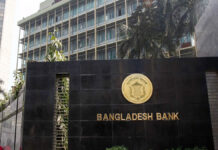‘Reverse of reforms, implementation delay key risks’
This March 11 photo shows BNP activists throwing brick chips on law enforcers during a clash in front of the party’s headquarters at Nayapaltan in the capital.
Political obstacles to passing and implementing reform legislation by Bangladesh and other South Asian countries pose downside risks, according to the World Bank.
“In countries either exiting (Pakistan) or entering electoral cycles (Bangladesh, India, Nepal), spending pressures associated with elections could boost fiscal expenditure, adding to inflationary pressures and both internal and external imbalances,” said Global Economic Prospects (GEP) report of the WB.
Risks in the post-election period include the possibility that past reforms are reversed or implementation delayed, adds the WB flagship report, which was released on Wednesday.
Weakening of external demands, inadequate supply of electricity and social unrest had slowed down growth of gross domestic product (GDP) to 6.2 percent in fiscal 2011-12 from 6.7 percent the previous fiscal year, it said.
The WB, in the report, even forecasted a further slowdown of the GDP for FY2012-13 due to subsequent macroeconomic tightening and political unrest.
The World Bank study found that the reserve position of Bangladesh has improved in the most recent period, from robust remittance inflows and a recent improvement in trade.
Sri Lanka’s reserves have also risen in line with an increase in private capital inflows.
By the first quarter of 2013, industrial production was rising at different paces in Bangladesh, India, and Pakistan, while in Sri Lanka, it stabilised in the fourth quarter of 2012.
As inflation moderated, monetary policy eased in Pakistan (in late 2012), in Bangladesh and India (in the first half of 2013), and in Sri Lanka (2012H2 and 2013H1) to support growth, it said.
However, inflation momentum remains strong, particularly in Bangladesh and India, mainly reflecting supply-side constraints and entrenched inflationary expectations, the report said.
Despite ongoing contraction in the Euro Area, risks from advanced economies have eased and growth is firming.
However, the pick-up in developing countries will be modest because of capacity constraints in several middle income countries, says the World Bank in its latest Global Economic Prospects (GEP) report.
Global GDP is expected to expand about 2.2 percent this year and strengthen to 3.0 percent and 3.3 percent in 2014 and 20151
Developing-country GDP is now projected to be around 5.1 percent in 2013, strengthening to 5.6 percent and 5.7 percent in 2014 and 2015, respectively.
Growth in Brazil, India, Russia, South Africa and Turkey has been held back by supply bottlenecks.
While external risks have eased, growth in these countries is unlikely to reach pre-crisis rates unless supply-side reforms are completed.
In China also, growth has slowed as authorities seek to rebalance the economy.
Looking at broader region-wide trends, the East Asia & Pacific region is expected to grow by 7.3 percent this year; Europe & Central Asia by 2.8 percent; Latin America & the Caribbean by 3.3 percent; Middle East & North Africa by 2.5 percent; South Asia by 5.2 percent; and Sub-Saharan Africa by 4.9 percent.
For high-income countries, fiscal consolidation, high unemployment and still weak consumer and business confidence will keep growth this year to a modest 1.2 percent, firming to 2.0 percent in 2014 and 2.3 percent by 2015. Economic contraction in the Euro Area is projected to be 0.6 percent for 2013, compared with the previous projection of 0.1 percent.
Euro Area growth is expected to be a modest 0.9 percent in 2014 and 1.5 percent in 2015.
“While there are markers of hope in the financial sector, the slowdown in the real economy is turning out to be unusually protracted,” Kaushik Basu, Senior Vice President and Chief Economist at the World Bank.
“This is reflected in the stubbornly high unemployment in industrialised nations, with unemployment in the Eurozone actually rising, and in the slowing growth in emerging economies, with India’s annual growth having dropped below 6 percent for the first time in 10 years. Also, there is heightened speculation that the US may withdraw QE and widespread concern about its consequences. By going into these topical matters, the World Bank’s latest Global Economic Prospects alerts us to both the hopes and the risks in the global economy, and also gives valuable instructions on policy.”
Global trade, after contracting for several months, is expanding once again, but trade is expected to expand only 4.0 percent in 2013, well off the pre-crisis pace of 7.3 percent. Not only will the volume of trade grow less quickly than in the past, the value of trade will grow even less quickly as commodity prices begin to ease in response to rapidly increasing supply. The prices of metals and minerals are already down by 30 percent and that of energy by 14 percent since their peaks in early 2011.
“The coming on stream of new mines and energy sources is putting downward pressure on most industrial commodity prices. If commodity prices were to decline even faster than expected, commodity exporting developing countries could experience serious fiscal setbacks and weaker growth,” said Hans Timmer, Director, Development Prospects Group.











